Do you think that once they are established in La Plata, the Spanish can expel the Mapuche from eastern Patagonia using the original peoples of the region (Pehuenches, Pulches, Quarandis, Teushens, Tehuelches)?
You are using an out of date browser. It may not display this or other websites correctly.
You should upgrade or use an alternative browser.
You should upgrade or use an alternative browser.
Un Dios, Un Imperio, Un Rey | Alternate TL.
- Thread starter Paladín Wulfen
- Start date
We can expect there's no more Mapuche after the Spanish arrival thoDo you think that once they are established in La Plata, the Spanish can expel the Mapuche from eastern Patagonia using the original peoples of the region (Pehuenches, Pulches, Quarandis, Teushens, Tehuelches)?
Well, let's hope that the Spaniards can quickly finish off the Mapuches in Araucania because, as Paladín Wulfen said, the war with the Mapuches was complete hell. If they manage to escape and subjugate the other tribes of eastern Patagonia, this conflict will be long and bloody.We can expect there's no more Mapuche after the Spanish arrival tho
Well. I almost finish the next chapter. In the next chapter we gonna have the visit of... Mapuches and Florida Man's
I can only pretend to fathom the horrors that lie ahead…Mapuches and Florida Man's
Tell me... What was the first US Vietnam War-style?I can only pretend to fathom the horrors that lie ahead…
De Oro y Agresion.
Although the Conquest of Northwest Africa was celebrated by Italians, Spanish, Portuguese and even some interior nations. It was quickly marred two years later by defeat at the Battle of Preveza, when a coalition made up of the Papal States, Spain, the Republic of Venice and the Knights of Malta faced a large Ottoman fleet under Hayreddin Barbarossa, the Baba Aruj's younger brother. The Battle of Preveza was a naval disaster that would make the space between the Straits of Sicily, Crete and Cyrenaica a naval battlefield between the Spanish fleets that departed from Sicily, Tunis or even Cartagena or Barcelona and the Ottoman Fleets that could sail from Tripoli, Alexandria and İstanbul along with other ports. However, the handing over of Carthage and Malta to the Knights of Saint John was not something done impulsively. The goal was to secure a faction that did not threaten their interests while continuing their actions against Muslims and especially pirates. The Knights of Saint John of Malta were the answer. Although they had only a few ships initially, they quickly incurred the ire of the Ottomans, who were not happy to see the re-establishment of order who went on to attack Tripoli burning half a hundred Ottoman ships without stopping to plunder. That action would be led by a young forty-year-old Jean Parisot de La Valette who earned a reputation that would astonish locals and strangers given his youth, and earned the same respect as Knight Mathurin Romegas, one of the greatest Christian marine commanders in that period that was considered the terror of the Muslims in the waters and coasts of the Mediterranean, continually raiding along the coast of Libya, the Levant and the Aegean Sea and capturing numerous ships and slaves. Jean Parisot and Mathurin Romegas would be close friends for the rest of their lives due to their joint hatred of the infidel.
However, in America the situation was different. The Inca Empire saw how the male Inca nobility was sent enslaved to serve in mines or inhospitable and strange places for them or even eliminated to avoid possible insurgencies motivated by racial values. Some Inca lords or caciques attempted to lead an insurgency like the Kingdom of Vilcabamba who, after waging a guerrilla war in the mountainous regions of Vilcabamba where they managed to gain victory in several fierce battles against the Spanish, but their fewer numbers, less equipment and less organization meant that they were finally crushed after ten years of insurgency. Manco Inca Yupanqui would end up executed by throwing himself off a cliff after being baptized in the Christian faith, although the execution would be based on crimes against the Spanish, including praying to the devil and consuming human flesh. Peru would be the Viceroyalty that emerged from the Inca Empire, although at first it was thought that it would be divided into different captaincies led by one of the leading Conquistadors such as Pizarro, Almagro, Alvarado or any other. The danger of conflict between all made the King obtained to send Pedro de la Gasca, a priest member of the Holy Office (Inquisition). Pedro de la Gasca would stand out for promoting the conquest, expansion and colonization of new lands to the south. Towards the southern lands known as Chile, the Spanish conqueror of Extremadura origin would be sent: Pedro de Valdivia, while the Río de Plata would be explored and colonized by Pedro de Mendoza and Luján. Pedro de Valdivia would stand out for having to cross with one hundred and fifty-three men and two clergymen distributed to one hundred and five horsemen and forty-eight infantrymen, plus a thousand Indian slaves dedicated to loading the equipment, whose slow walk carrying the baggage The pace of advance was determined by the vast, dry and fearsome Atacama Desert, hot (40 to 45°C) during the day and frigid (-10 to -5°C) at night.
The Valdivia expedition ran the risk of perishing after about two months of walking through the driest desert on the planet, where they only found depleted springs, and the army believed that it was going to perish in the battle against dehydration under the crushing sun from the southern region of the continent. But in the midst of desperation, the native of Plasencia, Inés Suárez ordered a group of slaves to dig "in the seat where she was", and when it had gone no deeper than a meter, the water gushed forth abundantly from aquifers formed by the centuries and the rains. Thanks to the water that even the slaves were grateful to drink even in spite of being the last, they were able a few days later to reach the splendid valley of Copiapó, or Copayapu in the indigenous language, but with their entrance they also came into conflict with hosts of the Diaguita ethnic group that They numbered up to ten thousand warriors, but the use of arquebuses as weapons of terror together with cavalry more mobile and stronger than any human wave charge, achieved victory and the beginning of colonization. Valdivia decided to baptize all the land that was in this valley to the south as Nueva Extremadura in memory of his native land. The Valdivia Expedition did not stop in that valley, even when tribal leaders tried to stop them with unsuccessful skirmishes until they reached a rock called Huelén in Mapudungún (Mapuche language) that divided a channel that descended from the Andes mountain range. Between the two arms formed by the split channel there was an island of flat land that seemed suitable for founding a city. Flanked to the north, south and east by natural barriers, the site allowed the conquerors to better defend the town from any indigenous attack. On the other hand, the aboriginal population was more abundant in the Mapocho valley than in the valleys further north, assuring the conquerors of labor to cultivate the land, and above all to exploit the mines that they still hoped to discover. despite the fact that the natives said they were scarce.
However, in America the situation was different. The Inca Empire saw how the male Inca nobility was sent enslaved to serve in mines or inhospitable and strange places for them or even eliminated to avoid possible insurgencies motivated by racial values. Some Inca lords or caciques attempted to lead an insurgency like the Kingdom of Vilcabamba who, after waging a guerrilla war in the mountainous regions of Vilcabamba where they managed to gain victory in several fierce battles against the Spanish, but their fewer numbers, less equipment and less organization meant that they were finally crushed after ten years of insurgency. Manco Inca Yupanqui would end up executed by throwing himself off a cliff after being baptized in the Christian faith, although the execution would be based on crimes against the Spanish, including praying to the devil and consuming human flesh. Peru would be the Viceroyalty that emerged from the Inca Empire, although at first it was thought that it would be divided into different captaincies led by one of the leading Conquistadors such as Pizarro, Almagro, Alvarado or any other. The danger of conflict between all made the King obtained to send Pedro de la Gasca, a priest member of the Holy Office (Inquisition). Pedro de la Gasca would stand out for promoting the conquest, expansion and colonization of new lands to the south. Towards the southern lands known as Chile, the Spanish conqueror of Extremadura origin would be sent: Pedro de Valdivia, while the Río de Plata would be explored and colonized by Pedro de Mendoza and Luján. Pedro de Valdivia would stand out for having to cross with one hundred and fifty-three men and two clergymen distributed to one hundred and five horsemen and forty-eight infantrymen, plus a thousand Indian slaves dedicated to loading the equipment, whose slow walk carrying the baggage The pace of advance was determined by the vast, dry and fearsome Atacama Desert, hot (40 to 45°C) during the day and frigid (-10 to -5°C) at night.
The Valdivia expedition ran the risk of perishing after about two months of walking through the driest desert on the planet, where they only found depleted springs, and the army believed that it was going to perish in the battle against dehydration under the crushing sun from the southern region of the continent. But in the midst of desperation, the native of Plasencia, Inés Suárez ordered a group of slaves to dig "in the seat where she was", and when it had gone no deeper than a meter, the water gushed forth abundantly from aquifers formed by the centuries and the rains. Thanks to the water that even the slaves were grateful to drink even in spite of being the last, they were able a few days later to reach the splendid valley of Copiapó, or Copayapu in the indigenous language, but with their entrance they also came into conflict with hosts of the Diaguita ethnic group that They numbered up to ten thousand warriors, but the use of arquebuses as weapons of terror together with cavalry more mobile and stronger than any human wave charge, achieved victory and the beginning of colonization. Valdivia decided to baptize all the land that was in this valley to the south as Nueva Extremadura in memory of his native land. The Valdivia Expedition did not stop in that valley, even when tribal leaders tried to stop them with unsuccessful skirmishes until they reached a rock called Huelén in Mapudungún (Mapuche language) that divided a channel that descended from the Andes mountain range. Between the two arms formed by the split channel there was an island of flat land that seemed suitable for founding a city. Flanked to the north, south and east by natural barriers, the site allowed the conquerors to better defend the town from any indigenous attack. On the other hand, the aboriginal population was more abundant in the Mapocho valley than in the valleys further north, assuring the conquerors of labor to cultivate the land, and above all to exploit the mines that they still hoped to discover. despite the fact that the natives said they were scarce.
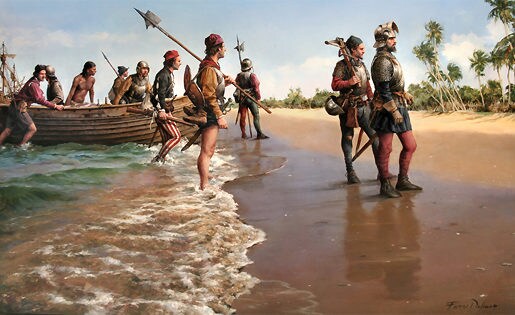
Pedro de Mendoza, on the other hand, was appointed on May 21, 1534, through the Capitulation of Toledo: Adelantado, which was equivalent to military commander of the area to be conquered, with the power to found fortresses and towns. The position of Adelantado had multiple attractions: it was hereditary, it combined the functions of governor, military leader and magistrate, it offered great economic possibilities (so the Adelantado, who had to pay for their own expeditions, used it to try to recover the invested capital), driven by the references of the Indians, that in the interior of the continent there were great riches in gold, silver and precious stones, namely Potosí and other areas of the Andean foothills. However, Pedro de Mendoza was unaware that the targeted areas were already under stalking by other adventurers advancing from Peru. Therefore, the colonization of Rio de la Plata was also a race to get the largest territory: the larger the area conquered, the larger the territory would be governed by the advance party in question, which encouraged the Spanish geographical advance against the Portuguese ambitions in some areas in competition. that motivated the appearance of Portuguese Bandeirantes. Pedro de Mendoza would leave Spain on August 24, 1535 in command of his expedition, made up of 15 ships and approximately 3,000 men together with 3,000 ducats given by the King and another important cash advance that the conqueror had to transfer to the Río de la Plata. But the task that was required of him in return was neither simple nor easy: transporting to their destination, in the space of two years, a thousand settlers, a hundred horses, founding three forts and building a royal road that would cross the Río de la Plata to the city of Lima in Peru. Obviously, the Spanish court was unaware of the dimensions of the terrain to be conquered and the enormous difficulties represented by the Andes Mountains, which stood in the way of the designed route. But for this reason, Mendoza formed his expedition in a rational and careful way: he took with him eight priests, a doctor and a surgeon.
In the middle of the voyage, off the coast of Brazil, Pedro de Mendoza's fleet was dispersed by a terrible storm. However, with effort and persistence, Pedro de Mendoza managed to reunite his ships and landed on the Brazilian coast, where he fell seriously ill due to weather and navigation conditions. Sick, he found himself giving temporary command to his lieutenant Juan Osorio, who soon showed signs of being responsible for treason and embezzlement. Mendoza had him executed and, somewhat recovered from his ailment, decided to embark again and continue heading south. In fact, the advance guard remained almost the entire trip in his bunk until he found his death. Pedro de Mendoza's expedition entered the Río de la Plata in mid-January 1536 and landed on San Gabriel Island. On January 22, the soldiers and other members of the expedition swore fidelity and obedience to Pedro de Mendoza, who began to exercise his position as governor from that day. After exploring both coasts of the River Plate estuary, Mendoza decided to settle on the right bank, in a place where he found sources of drinking water and a relatively repaired coast. Between February 2 and 3, 1536, Pedro de Mendoza established a port defended by a fort on the southern bank of the Río de la Plata, which he called Santa María del Buen Aire, an appellation of the Virgin of the sailors of Sardinia. In this place he settled down together with his expeditionaries. As soon as they settled down, the Spaniards discovered a large host of aboriginal natives, the querandíes, of at least 3,000 men, with whom they exchanged gifts for food. However, shortly after arriving, serious problems began. Contact with the Spanish caused the Querandíes to become ill and stop feeding the camp which caused Pedro de Mendoza to send messengers to contact the tribe who were aggressively repulsed by the natives.
The lack of food forced Governor Mendoza to send garrisons in all directions to look for food to alleviate the famine, but these contingents were ignored and harassed by different indigenous tribes. Eager to put an end to the problem, Don Pedro sent a force centered on the corps of 300 veteran soldiers of the Tercios, commanded by his brother Diego de Mendoza to attack the Querandíes. Both sides clashed on June 15, 1536, near Laguna de Rocha. In the confrontation, the Indians killed about thirty-five Europeans, while they exterminated a thousand warriors, without taking any prisoner among the warriors. But shortly after this aggression, the Querandíes grouped themselves with four other nations, the Chaná-Timbu, the Guaraníes and the Charrúas, and began to harass the town by besieging it by land. At the end of June, the indigenous people assembled a large army of twenty-three thousand made up of the Querandí, Guarani, Charrúa, Zechanáis and Timbus tribes. In the siege, Pedro de Mendoza would die due to illness and violence, being replaced by Juan de Ayolas who had several cannons landed from the ships to use against the attacking tribes. After that, a ship would be sent back with the body and a report of what happened to Spain. The victory against the natives in the siege of Santa María del Buen Aire caused the natives to retreat, at the same time transporting diseases that would weaken their tribes and would end up infecting rather than facilitating when in November 1536, new settlers arrived, especially veterans of the Thirds that offered more soldiers to fight against the hostile tribes.

However, in the north. In May 1539 an expedition was started. This expedition led by the veteran of the Conquest of Peru, Hernando de Soto. De Soto was motivated by the Spanish raids prior to his, carried out by Juan Ponce de León and Álvar Núñez Cabeza de Vaca. Hernando de Soto would land on the western coast of Florida with a force of 700 men, 24 priests, 9 ships, and 220 horses. Shortly after disembarking, he quickly baptized the area with the name of Holy Spirit. Hernando de Soto's objective was to colonize the area, motivated by rumors of cities like Cuzco or Tenochtitlan. To support such an undertaking, he brought several tons of equipment distributed in tools, weapons, cannons, dogs, and pigs. In addition to sailors, the ships brought priests, blacksmiths, artisans, engineers, farmers, and merchants. Few of them had traveled outside of Spain before, or worse, had not even left their hometowns. The Spanish combat forces had a clear division between cavalry and infantry: the former were the most powerful, since in addition to their corps they provided weapons and horses; most of them were hidalgos (minor nobles comparable to glorified knights), but there were higher-ranking nobles who held the main commands; the infantry was made up of peasants and people of low social extraction who, like the nobles, dreamed of getting rich soon and returning to Spain having improved their condition. However, the problems arose as soon as they set foot on land in Florida when the inevitable changes began: on the one hand, because both people and animals died in hostilities with the natives, and on the other, because many times the Indians were taken prisoner to be used as guides, interpreters or simple servants. The mere landing of an army like the one described in lands populated by Indians already supposes a notable alteration in the order of things and in the daily routine of the natives.
The first contacts are difficult and traumatic, with large doses of amazement, fear and caution on both sides. It goes without saying that the news of the arrival of the Spaniards spread like wildfire among the Floridian Indians of very different tribes, giving rise to contrary reactions between them. Without leaving the coast where the army had landed, the first "province" they enter is that of the cacique Hirrihigua, who kept a memory of the fights and punishments inflicted by Pánfilo de Narváez ten or twelve years ago and He opposes the invasion of his land again. The inevitable hostilities or skirmishes between Castilians and Indians arose, until Hirrihigua, aware of his inferiority, went to the mountains, abandoning his house and town. In the middle of the combats against Hirrihigua, he would highlight the appearance of a friendly face for the Spanish under the cry of "Sevilla! Seville!". This man would be Juan Ortiz who was captured by Native Americans in Florida for eleven years. Thanks to Juan Ortiz and his eleven years of experience, Hernando de Soto found a trustworthy explorer and interpreter who would help Hernando de Soto cross Florida without too many problems, given that intimidated by the military superiority exhibited by the Spanish, the natives chose to abandon their villages and disperse, alerted to the approach of the Hispanic forces. Hernando de Soto would build the city of Nueva Cadiz in the Bay of Espiritu Santo while he continued heading north. Later, he would make a colony in his winter camp at Anhaica, near Lake Tallahas, belonging to the Appalachian Indian people who were forced to leave the village.
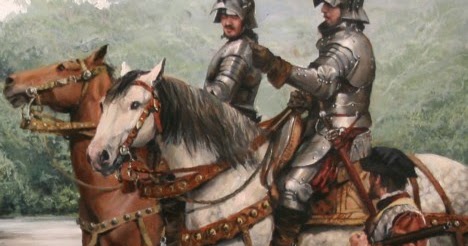
Even with the absence of Hernando de Soto, the settlers did not take long to use the ships to get more resources, even motivate the arrival of new settlers, whether they were civilians or warriors who did not care about winning every meter of land shedding indigenous blood. As in all the conquests and wars of yesterday and today in America, where the tribes took the worst part. They were easy prey in the raids, so that sometimes they died and others went into captivity, in some cases Spanish war parties broke in by surprise killing, stealing and looting everything they found, taking women and daughters as domestic slaves or even trading with the other Spanish domains such as Cuba, Cartagena de Indias, Mexico, including the Canary Islands. The Spanish groups stood out for a wide range of actions, from the so-called "double treatment" (feigned friendship) to total and absolute belligerence, which used to end in a fierce battle that ended with the majority of men killed either by murder or suicide. to avoid slavery, but still the elderly, women and children suffered the worst fate as slaves. But even so, Florida turned out to have quite an agricultural industry in citrus foods such as peppers, tomatoes, strawberries, peaches, grapefruit, oranges, sugar cane and watermelons. This growth made food from Florida quite well received, as well as Tobacco, which was a product exported to Spain and from there to Europe, which brought significant profits.
So a much stronger presence in both Argentina and Florida, interesting. Will we still see a Iberian Union TTL? It'll give the Spaniards access to even more money thanks to the portuguese presence in Asia and India, will unify Brazil into the rest of Spanish America and will add more lands to the crown(already considering their titles of Kings of Castile, Aragon and hopefully of France soon).
It should also be noted, the Portuguese only broke off with Spain because of the severe decadence the empire was in and even then it took quite a while for it to happen. Without this here, both the nobles and especially the merchants will be very happy in getting into a union and especially if there's legitimacy.
It should also be noted, the Portuguese only broke off with Spain because of the severe decadence the empire was in and even then it took quite a while for it to happen. Without this here, both the nobles and especially the merchants will be very happy in getting into a union and especially if there's legitimacy.
Weee, Super La Plata and Super Florida. One devouring all of southern Brazil to Sao Paulo and the other reaching the banks of the Mississippi River.So a much stronger presence in both Argentina and Florida, interesting. Will we still see a Iberian Union TTL? It'll give the Spaniards access to even more money thanks to the portuguese presence in Asia and India, will unify Brazil into the rest of Spanish America and will add more lands to the crown(already considering their titles of Kings of Castile, Aragon and hopefully of France soon).
It should also be noted, the Portuguese only broke off with Spain because of the severe decadence the empire was in and even then it took quite a while for it to happen. Without this here, both the nobles and especially the merchants will be very happy in getting into a union and especially if there's legitimacy.
Try not to kill all the Guarani, from somewhere the people of La Plata have to discover the Mate  . Now seriously, the greater Spanish presence in La Plata and Florida will transform these viceroyalties into the breadbaskets of the empire and perhaps small regional manufacturing powers in the future.
. Now seriously, the greater Spanish presence in La Plata and Florida will transform these viceroyalties into the breadbaskets of the empire and perhaps small regional manufacturing powers in the future.
*Drinking Mate* they gonna be slaves...Try not to kill all the Guarani, from somewhere the people of La Plata have to discover the Mate. Now seriously, the greater Spanish presence in La Plata and Florida will transform these viceroyalties into the breadbaskets of the empire and perhaps small regional manufacturing powers in the future.
Extremo Oriente
«Dai Nihon wa kami no kunidesu. Ten no sosen ga sore o setsuritsu shi, taiyō no megami wa sore o shison ni eien ni shihai suru yō ni izō shimashita. Watashitachi no kuni dake ga kore ni atehamarimasu. Hoka no kunide wa dōyō no rei wa arimasen. Kore ga, wagakuni ga kami no kuni to yoba reru yuendesu.».
«Great Japan is the divine land. The heavenly progenitor founded it, and the Sun Goddess bequeathed it to her descendants to rule eternally. Only in our country is this true; there are no similar examples in other countries. This is why our country is called the divine land.».
— Kitabatake Chikafusa, Jinnō Shōtōki (A Chronicle of the Direct Descent of Gods and Sovereigns)
«Great Japan is the divine land. The heavenly progenitor founded it, and the Sun Goddess bequeathed it to her descendants to rule eternally. Only in our country is this true; there are no similar examples in other countries. This is why our country is called the divine land.».
— Kitabatake Chikafusa, Jinnō Shōtōki (A Chronicle of the Direct Descent of Gods and Sovereigns)
On September 23, 1543, a Chinese Junk ship led by Chinese pirate Wang Zhi, a Chinese pirate lord who engaged in smuggling across the East and South China Seas from Japan to Thailand during the maritime prohibition period of the Chinese Ming dynasty, en route to Ningbo, was swept off course by a bad storm that caught the ship off guard. Inside the same boat, several Portuguese merchants were traveling, including António Mota, António Peixoto, Francisco Zeimoto and Fernão Mendes Pinto. The storm ended up taking the Chinese ship to Tanegashima, a Japanese island southeast of Kyushu within the Japanese archipelago. The Lord of Tanageshima who received the title of Daimyo indicating that he was a Feudal Lord, was Tokitaka Tanegashima who was only 15 years old and, faced with the strange appearance of the Portuguese, caused a local sensation that led to their being brought before Lord Tokitaka. The Portuguese, with the help of Wang Zhi, were able to communicate with the Japanese using Chinese characters since China and Japan shared the same written script at that time. The interest of the young lord of Tanageshima was drawn to the matchlocks worn by the Portuguese who made a demonstration to the lord. Lord Tokitaka Tanegashima instructed his swordsmith, Yaita Kinbei Kiyosada to create functional replicas of the weapons but although he didn't have much trouble with most of the barrel, when it came to drilling the barrel helically so that the screw (bisen bolt) could be tightly inserted, the difficulty was significant given that the technique apparently did not exist in Japan until this time. The Japanese were already familiar with gunpowder weaponry (invented and passed down from China), and had been using basic cannon of Chinese origin and cannon tubes called "Teppō" ("Iron Cannon") for some 270 years before the arrival of the Portuguese. In comparison, the Portuguese cannons were light, had a matchstick firing mechanism, and were more accurate and easier to aim. A year later, a Portuguese blacksmith arrived in Japan who taught Japanese swordsmiths and blacksmiths how to make arquebuses, allowing them to reproduce the matchlock and mass-produce firearms, revolutionizing the Japanese art of war.

Common Tanegashima Model Arquebus compared with european arquebuser.
But on the other hand, the discoveries and political-economic interests of the Portuguese and Spanish empires had led them to draw up a distribution of spheres of influence in the face of exploration, conquest and economic exploitation of the territories that were coming to light on the maps. Europeans. In 1494, Spain and Portugal signed the Treaty of Tordesillas, which drew a meridian 370 leagues west of the Cape Verde Islands to divide the world into two parts: one Spanish to the west and the other Portuguese to the east. The Spanish understood and interpreted that the two areas of influence were exactly the same in terms of the number of meridians they covered, that is to say that both areas extended from pole to pole, each one covering 180 degrees from east to west (which is the same as to say that the Tordesillas line continued, after crossing the poles, through the opposite hemisphere). The Portuguese never admitted such a Spanish interpretation until decades later, when the expedition of Magellan and Elcano, completing its circumnavigation in 1522, demonstrated that the Indian Ocean was open to navigation on both sides, then it became clear that the interests of Spain and those of Portugal were going to come into conflict, since both powers, each sailing through their own area of influence, were able to access East Asia. It is important to point out that, in those days, it was technically impossible to know with certainty whether certain lands (most notably the Moluccan Islands, also known as the Spice Islands) were in the Spanish or Portuguese area, and that uncertainty was the source of endless questions. discussions, and to this was added the fact that the Portuguese still did not accept the Spanish interpretation that the antipodal meridian to that of Tordesillas was a valid delimiter with which the Earth could be divided into two equal hemispheres. This is how the monarchs of both States were forced to complete the distribution.
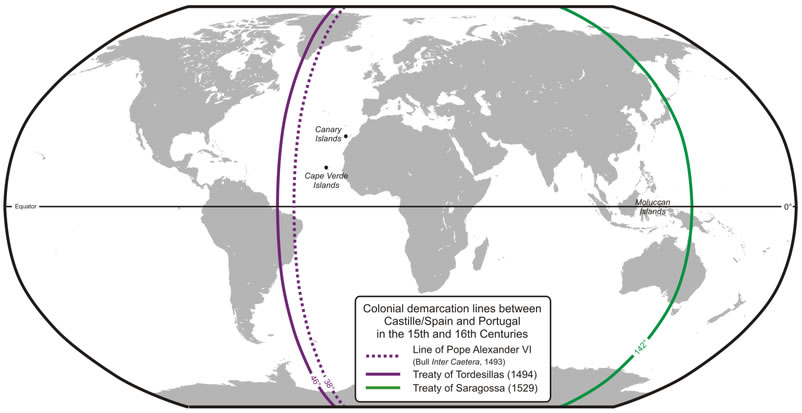
This new treaty, which modified or completed (according to the Spanish or Portuguese opinion respectively) that of Tordesillas, was the Treaty of Zaragoza (1529), which set the limits of the peninsular domains in Asia. The Zaragoza Treaty established a new demarcation meridian, located 1,763 kilometers east of the Moluccas Islands. By signing this treaty, Spain not only renounced the Moluccan Islands, but also abandoned its claim that the globe be divided into two parts of equal size: in fact, even at that time it was clear that the zone of Portuguese influence, as of the Treaty of Zaragoza, it covered an area greater than the Spanish part. However, in the following decades the treaty would not be fulfilled in its entirety, since Spain undertook missions with the aim of colonizing islands that were clearly on the Portuguese side. Magellan's exploration had led to the discovery of new lands that Fernando I of Spain coveted: the Philippine Islands. This set of islands was not yet known by this name, but Magellan had baptized them as the Poniente Islands or the San Lázaro archipelago. Possession of a territorial base in this area was a succulent commercial morsel, since it allowed access to trade with China and Japan. In addition, there was access to spices (cloves, cinnamon, pepper...), tremendously valued in sixteenth-century Europe. We must take into account that this trade had been until then a monopoly of the Portuguese, who had become rich thanks to it. The problem for Fernando I was that in the Treaty of Zaragoza, Spain had recognized the Portuguese sphere of influence and its possession of the Moluccas Islands, large producers of spices. The Philippines were in a borderline situation as far as the treaty was concerned, so Ruy López de Villalobos was given severe instructions to limit himself to trying to explore and colonize the Philippines while avoiding Portuguese territories.
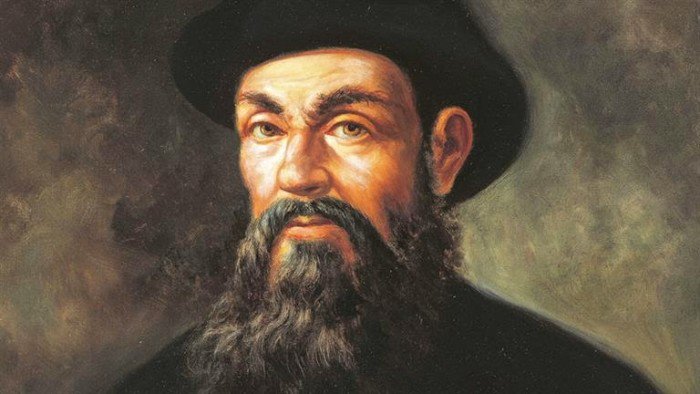
Ruy López de Villalobos
In 1541, Ruy López de Villalobos was commissioned by Antonio de Mendoza y Pacheco, the first viceroy of New Spain, to lead an expedition to the Poniente Islands (East Indies). The expedition departed from the Mexican port of Barra de Navidad on November 1, 1542, a fleet of 400 crew members aboard four larger ships, a brigantine and a schooner: Santiago, Jorge, San Antonio, San Cristóbal (piloted by Ginés de Mafra ), San Martín and San Juan de Letrán (under the command of Bernardo de la Torre). On December 25, the fleet headed for the Revillagigedo Islands, off the west coast of Mexico, one of whose islands had been discovered in 1533 by Fernando de Grijalva. The next day they rediscovered a group of islands which they called Corrales, and they anchored on one of these islands, which they named La Anublada, and gave the rocks the name of Los Inocentes. On January 6, 1543, they sighted several small islands at the same latitude and called them Islas Los Jardines (they were the islands of Eniwetok and Ulithi, already sighted in 1527 by the galleon Reyes, the ship commanded by Álvaro de Saavedra that Cortés had sent to cross the Pacific). They also discovered the island of Palau and Hawaii Archipelago. Between January 6 and 23, 1543, the galleon San Cristóbal, piloted by Ginés de Mafra, who had been a member of the crew of the Magellan-Elcano expedition in 1519 to 1522, was separated from the fleet during a strong storm. This ship eventually reached the island of Mazaua, a place where Magellan had anchored in 1521. This was Mafra's second visit to the Philippines. On February 29, the expedition entered Baganga Bay, which they called Malaga, on the eastern coast of the island of Mindanao. The fleet remained there for 32 days, the entire crew suffering from extreme hunger. He ordered his men to plant corn, but failed. On March 31, 1543, the fleet set out, attempting to return to Mazaua, in search of food. After several days of hardship, they reached Sarangani.

Fortunately, the galleon San Cristóbal, which had arrived in Limasawa two months earlier, turned up unexpectedly with a cargo of rice and other food. On August 4, the San Juan and San Cristóbal were sent back to the islands of Leyte and Samar for more food. Then, a Portuguese contingent arrived on August 7 and handed them a letter from Jorge de Castro, governor of the Moluccas, demanding an explanation for the presence of the fleet in Portuguese territory. López de Villalobos replied that they were not invading, and were within Spain's demarcation line. For later, the San Juan, with Bernardo de la Torre as captain, was sent back to New Spain, departing on August 27, to find a suitable route for the "return navigation". The ship discovered several islands, but when not Finding favorable winds, it was forced to return to the Philippines. In the first week of September another letter arrived from Castro with the same protest, and López de Villalobos wrote a new response, with the same message as the first. He set out for Abuyog, in Leyte, with the remaining ships, the San Juan and the San Cristobal. However, the fleet was unable to proceed due to unfavorable winds. In April 1544 he sailed for the island of Amboina. Villalobos and his crew then headed for the islands of Samar and Leyte, which they named the Philippine Islands in honor of Spain's crown prince, the future King Philip I of Spain. Driven out by hostile natives, famine, and shipwreck, López de Villalobos was forced to abandon his settlements on the islands and the expedition. Faced with the situation, they sought refuge in the Moluccas, and after some skirmishes with the Portuguese, they were unjustly imprisoned by the Portuguese to the point that López Villalobos died on April 4, 1546, in his prison cell on the island of Amboina, from a tropical fever. On his deathbed he was attended by the Jesuit Francisco de Jaso who was then on an evangelization trip in the Moluccas under the protection of the King of Portugal, and as Papal Nuncio in Asia.
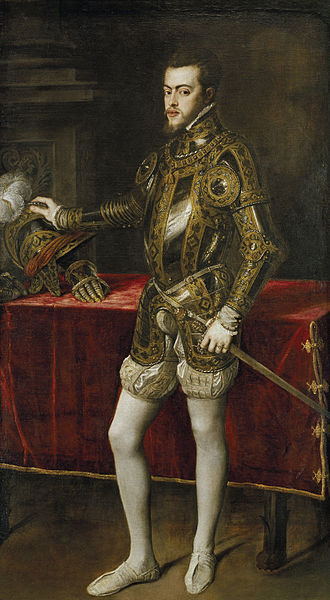
Painting about Philip I of Spain
Fernando I, seeing the fate of the first expedition. He decided to continue the expansion of the islands coveted also by the English, Dutch and Portuguese. Luckily, the Spaniards managed to find the circuit of ocean currents and favorable winds for navigation between America and the Philippines thanks to a Portuguese ship that arrived in New Spain from Asia. Using this information, in 1550 Miguel López de Legazpi was ordered to lead an expedition with the goal of conquering the Philippines. On September 1, 1550, the president and listeners of the Royal Audience of Mexico give Legazpi the document specifying the instructions and orders that the expedition carried. The extensive document, which occupied more than twenty-four pages, detailed a whole code of rules of control, behavior and organization, as well as the recommendation of treatment of the natives, which went so far as to indicate how the rations should be distributed and prevent the existence of useless mouths that hindered the expedition. Apart from the instructions given, which included a caveat regarding service, by granting a dozen people assigned to these tasks, prohibiting any other type of boarding: Indian men or women, black men or women, no women, married or single of any kind. quality and condition whatever, except for up to a dozen black men and women slaves, who would be distributed in all the ships along with these instructions came the appointment of «Admiral, General and Governor of all the lands he conquered» With the five ships and About 350 men, the expedition led by López de Legazpi departed from the port of Barra de Navidad, Jalisco, on November 21, 1551 after the flag and banners were blessed on November 19. The expedition crossed the Pacific in 93 days and passed through the Mariana archipelago. On January 22 they landed on the island of Guam, known as the Island of Thieves, which they identify by the type of sails on their boats and canoes that they see.
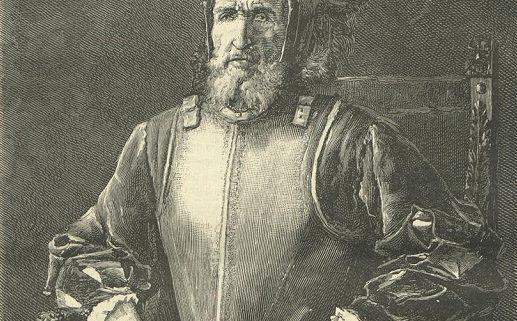
Miguel López de Legazpi
Legazpi ordered that no one should abandon the ships without authorization and that those who did so should not use force, avoiding causing harm or injury to the natives, while also not stealing supplies, seeds or trees, while not hiring natives unless they were officials. of the King with serious penalties for the acting and the captains who consented to it. Legazpi decided to buy food from the natives at the time that he took possession of the island for the Spanish Crown. On February 5 they leave for the so-called Poniente Islands, the Philippines. On the 15th, they made landfall on the island of Samar, where the lieutenant major, Andrés de Ibarra, took possession of it after agreement with the local leader. On the 20th of the same month, they set out to sea again and arrive in Leyte, where Legazpi lifts the formal act of taking possession, despite the hostility of its inhabitants, who tried to attack them but were repelled with the use of muskets. and swords. On March 5 they arrive at the port of Carvallán only to face a food shortage that prompted the search for new bases, for which the Spanish dominions were extended over the different islands, coming to dominate a large part of the archipelago in a matter of months. except for Mindanao and the Sulu Islands. This expansion was carried out with relative ease, as the different peoples who occupied the islands were in conflict with each other, and Legazpi established friendly relations with some of them, for example, with the natives of Bohol by signing a "pact of blood" with Chief Sikatuna. The abuses that the Portuguese navigators had committed in the past in some points of the archipelago motivated some towns to oppose Legazpi with a strong resistance, which made him give permission to wage war to those natives who refused to sell them supplies at fair prices and used. His longing for peace ran into the misgivings of the local governor, Rajah Tupas, who was the son of the man who years earlier had killed 30 men from Magellan's expedition at a cheating banquet.
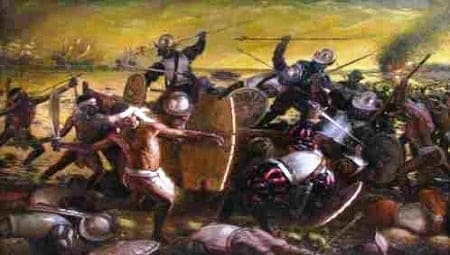
Legazpi tried to negotiate a peace agreement, but Tupas sent a force of 2,500 men against the Spanish ships, who repelled the attack using their cannons as artillery while acting as castles, easily repelling the attack. After the battle, Legazpi again tried to agree to its peaceful settlement and was again rebuffed. Faced with diplomatic rejection, the Spanish troops began to disembark in three boats under the command of Goiti and Juan de la Isla, while the ships fired their cannons at the town, destroying some houses and making the inhabitants flee. The Spaniards, who were in desperate need of supplies, searched the town without finding anything that could serve them. During the looting, one of the soldiers from Legazpi, born in Vizcaya, finds the image of the Child Jesus in a hut. Legazpi, motivated by the symbolism, orders the work of the fort to begin, which begins with its layout on May 8. Given these facts, King Tupas tried to recover his dominions, but ended up defeated and Legazpi had him punished for various crimes that included treacherously attacking unarmed Spaniards and attacking subjects of the king. After the execution of King Tupas, the first Spanish settlements were founded there: the Villa del Santísimo Nombre de Jesús, naming Pedro Briceño de Oseguera, alderman of the same; and the Villa de San Miguel although it would be abbreviated as Cebu City, which would become the capital of the Philippines and based on the conquest of the same. After sending to New Spain as a messenger the Augustinian friar Andrés de Urdaneta, who was a relative of López de Legazpi. In the midst of events, the Portuguese ordered by Afonso de Noronha, Viceroy of Portuguese India, launched two attacks that were rejected by Legazpi between 1552 and 1553. In response to the Spanish expulsion from the Moluccas, Fernando I decided to maintain control over the Philippines. For this he appointed Legazpi Governor and Captain General of the Philippines and sent reinforcement troops.
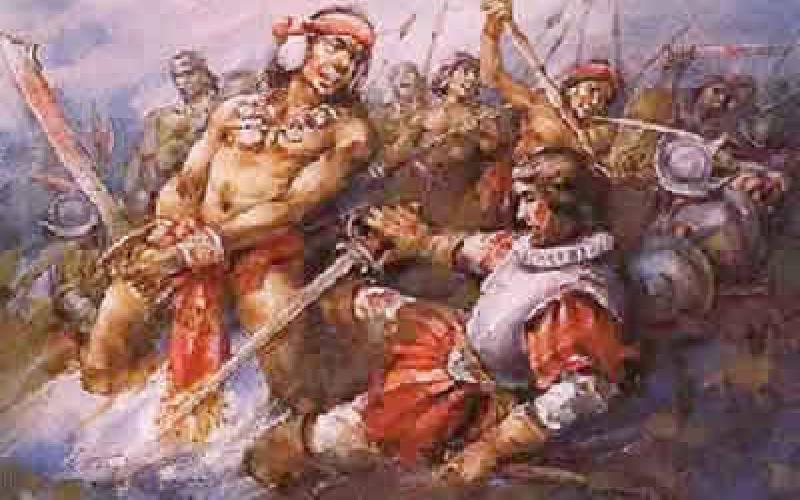
While the reinforcements arrived in the Philippines, Legazpi had to face a native uprising, which he suppressed. In 1554, the galleon San Gerónimo arrived from Mexico, thus definitively confirming the Philippines-America route. In 1555, 2,100 Spanish soldiers and workers arrived in Cebu on orders from the king. They founded a city and built the port of Fortaleza de San Pedro, which became their outpost for trade with Mexico and protection against hostile native rebellions and attacks by the Portuguese, which were definitively repulsed. The new possessions would be organized under the name of Philippine Islands. Legazpi would stand out as administrator of the new domains, where he introduced parcels, copied from the way it was done in America, and activated trade with neighboring countries, especially with China, for which he took advantage of the colony of Chinese merchants established in Luzon. since before your arrival. The religious question remained in the hands of the Augustinians led by Fray Andrés de Urdaneta. The López de Legazpi family would essentially rule the Captaincy General of the Philippines through puppet captain generals and the Audiencia and Royal Chancery of Manila, owning over a hundred thousand slaves and becoming one of the most influential families, several López de Legazpi being presidents of the Audiencia or Captains General. However, the prosperity of the Maynilad settlement attracted the attention of Legazpi as soon as he learned of its existence in 1556. To conquer it, he sent two of his men, Martín de Goiti and Juan de Salcedo, on an expedition under the command of some 300 soldiers. Maynilad was a Muslim enclave, located in the south of the island of Luzon, dedicated to trade. Salcedo and Goiti arrived in Manila Bay on May 8, after having fought several battles in the north of the island against pirates of Chinese origin. The Spaniards are surprised by the size of the port and are received in a friendly way, camping for some time in the vicinity of the enclave.
City of Manila Map
Soon after, incidents broke out between the natives and the Spanish and two battles took place, the natives being defeated in the second of them, with which control of the area passed into Spanish hands after looting that lasted three days. With the conquest of Maynilad, control over the island of Luzon was completed, which Legazpi called the New Kingdom of Castile. Recognizing the strategic and commercial value of the enclave, on June 24, 1557, Legazpi founded the Always Loyal and Distinguished City of Spain in the East of Manila and that would become the seat of government of the archipelago and of the Spanish domains of the Far East. The construction of the city —divided into two zones, the intramural and the extramural— was due to Spanish colonial urban planning regulations that planned the intramural area in the Spanish style of the time, with a defensive character according to plans by Juan de Herrera, architect of El Escorial, and leaving outside the walls for the indigenous villages that would later give rise to new towns and would end up, over time, integrating part of the city of Manila. After proclaiming Manila the capital of the Philippine archipelago and of the Spanish domains in the Far East, López de Legazpi would move his residence there, while the Philippines would be a preferred destination for many Basques and those born in the north of Spain who would end up having important plantations. of corn, tomatoes, potatoes, chili peppers, chocolate, pineapples, sugar and tobacco, all maintained by the slave labor of hundreds of natives at the time that the Philippines would also become the Spanish distribution center for silver mined in the Americas, which had a great demand in Asia. In exchange for this silver, Manila gathered Indonesian spices, Chinese silks, and Indian gems for export to New Spain and from there to Spain.
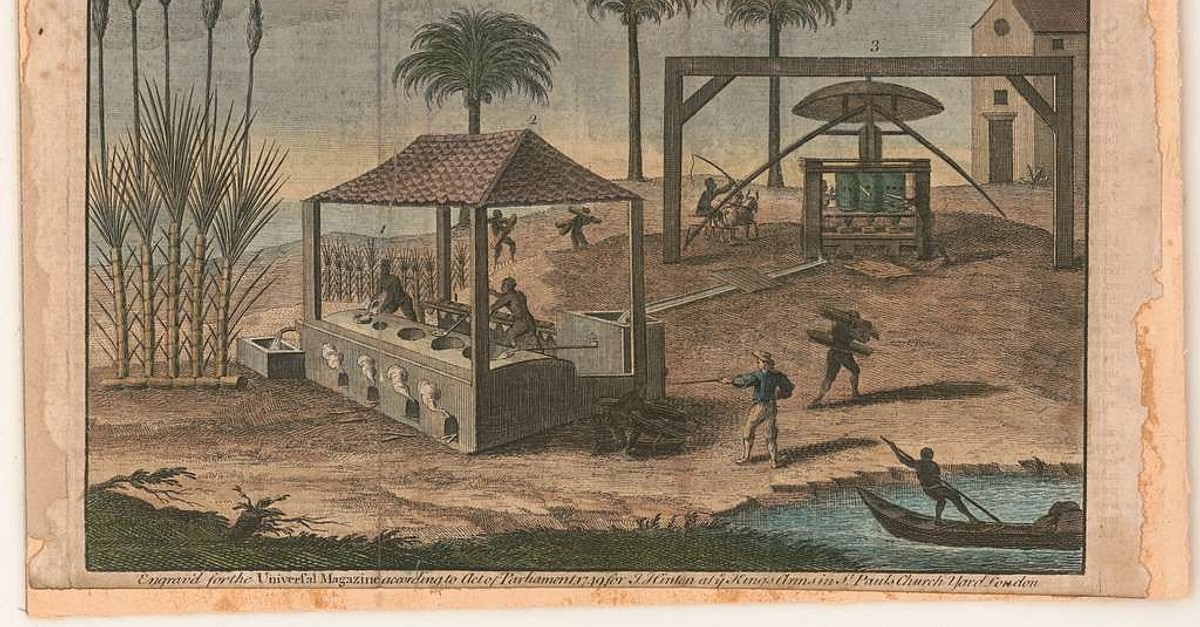
While the events in the Philippines were happening. In December 1547, the Navarrese Catholic missionary and co-founder of the Society of Jesus: Francisco Javier would meet a Japanese named Anjirō who, having been accused of murder, had fled from Japan. Anjirō told Francis at length about his former life, and the customs and culture of his homeland. Anjirō would become the first Christian of Japanese origin and would adopt the name 'Paulo de Santa Fé'. At the same time, he would help Xavier as a mediator and interpreter for the mission to Japan. Years later, Francis Xavier, with Anjiro and three other Jesuits, would arrive in Japan on July 27, 1549, but would not be allowed port access until Palm Sunday, August 15, when he arrived in Kagoshima, Japan's main port. the province of Satsuma on the island of Kyūshū. Once there, Shimazu Takahisa, daimyō of Satsuma, would give Francis a friendly reception on September 29, 1549. Takahisa was the first daimyō to bring Western firearms to Japan due to his control of Tanegashima. Lord Shimazu would grant the Jesuits protection to spread Christianity in his domain, but the following year he retracted his support for Christianity under pressure from local Buddhist monks and forbade the conversion of his subjects to Christianity on pain of death; The Christians in Kagoshima could not be given any catechism in the following years because of it. Francis brought with him paintings of the Madonna and the Madonna and Child. These paintings were used to help teach the Japanese about Christianity as there was a huge language barrier as Japanese was different from other languages Francis Xavier had previously encountered. For a long time Francis struggled to learn the language with the help of Anjirō's family in Yamaguchi until October 1550. He almost met the Emperor of Japan at Christmas 1550 but was forced to return to Yamaguchi where the daimyō of the province told him gave permission to preach... and this start the christianity in japan.
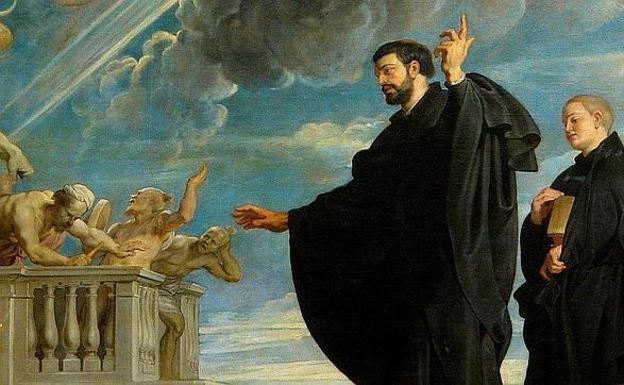
Francisco Javier.
Interesting development, Spanish get a much tighter grip on the Philippines economically and politically and are also intruding in Japan. Given the way the Spanish are managing to encroach into Asia, could we see them doing the same with East Africa? The Kingdom of Prester John is there after all bravely fighting against the Muslims and it just so happens to control a strategic chokehold on the Red Sea, one that if the Ethiopians are fully able to control it if the most catholic Spanish people sold him fire arms and cannons to conquer the region and allow them not only exclusive trading rights but also navy bases, allowing the Spaniards to threaten the Ottomans even harder...
Maybe, I try give realism and don't make a nationwank. Spain massive expansion come thanks to Adelantados Conquistadores who act like pathfinder for the conquest.Interesting development, Spanish get a much tighter grip on the Philippines economically and politically and are also intruding in Japan. Given the way the Spanish are managing to encroach into Asia, could we see them doing the same with East Africa? The Kingdom of Prester John is there after all bravely fighting against the Muslims and it just so happens to control a strategic chokehold on the Red Sea, one that if the Ethiopians are fully able to control it if the most catholic Spanish people sold him fire arms and cannons to conquer the region and allow them not only exclusive trading rights but also navy bases, allowing the Spaniards to threaten the Ottomans even harder...
The next chapter gonna be in Europe... Prepare for see the rise of the Blood Queen who love his husband more even his own nation.
Understandable but them having a presence in East Africa/Ethiopia isn't too hard to do it, especially since they're not controlling the territory directly but just having a lucrative deal with the ancient Christian kingdom that will give them lots of benefits without much cost.Maybe, I try give realism and don't make a nationwank. Spain massive expansion come thanks to Adelantados Conquistadores who act like pathfinder for the conquest.
The next chapter gonna be in Europe... Prepare for see the rise of the Blood Queen who love his husband more even his own nation.
Also, a perfect way of introducing coffee to the rest of the world and make a killer profit by planting it in their colonies.
.... Hermano... The translation.Ahora España necesita luchar un poco con los otomanos e invadir Inglaterra y pueden sentarse y ver cómo prospera el imperio hasta que algo suceda en Francia o Portugal.
*Playing with an Axe*Please dont screw portugal over
You say what?
*The axe slip and go to Portuguese side*
Shit.
Share: